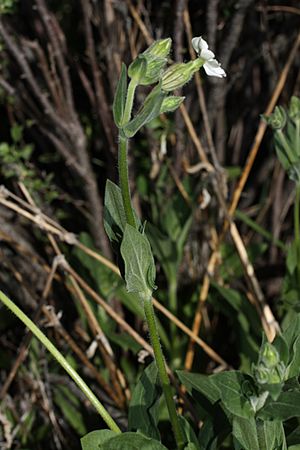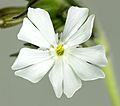White campion facts for kids
Quick facts for kids White campion |
|
|---|---|
 |
|
| Scientific classification | |
| Genus: |
Silene
|
| Species: |
latifolia
|
| Synonyms | |
|
|
Silene latifolia, also known as white campion, is a beautiful flowering plant. It belongs to the plant family Caryophyllaceae. This plant is special because it has separate male and female plants.
White campion grows naturally in most parts of Europe, Western Asia, and northern Africa. It is a herbaceous plant, meaning it has soft stems, not woody ones. It can live for one year (annual), two years (biennial), or a few years (short-lived perennial). White campion usually grows to be about 40 to 80 centimeters tall. In the US, it is sometimes called bladder campion. However, be careful not to confuse it with Silene vulgaris, which is also called bladder campion.
The way white campion looks changes as it grows. When young, it has a group of oval-shaped leaves at its base. These leaves are about 4 to 10 centimeters long. As the plant gets older, branched stems grow from the base. These stems have leaves growing in pairs on opposite sides.
The plant's flowers grow in bunches at the top of the stems. Each flower is about 2.5 to 3 centimeters wide. They have a unique puffed-up part called a calyx. There are five white petals, and each petal has a deep notch or cut. White campion flowers from late spring until early autumn. The whole plant is covered in many tiny hairs. Sometimes, you might see plants with pink flowers. These are usually hybrids (mixes) with red campion (Silene dioica).
Contents
Where White Campion Grows
White campion can be found in many open areas. It especially likes wasteland and fields. It grows best in soils that are neutral or alkaline (not too acidic). Even though it can grow in many places, it prefers sunny spots. It also likes soil that is rich and drains water well. For example, you can find it in the Sarmatic mixed forests.
In some parts of England, white campion is called the Grave Flower or Flower of the Dead. This is because it is often seen growing on graves and around tombstones.
This plant has also spread to North America. It is now found in most parts of the United States. You can see the largest groups of white campion in the north-central and northeastern areas of the country. Scientists believe S. latifolia came to North America on ships. It likely traveled hidden in the ship's ballast, which is material used to balance the ship.
How White Campion Reproduces
S. latifolia is a dioecious plant. This means that there are separate male plants and female plants. The sex of a white campion plant is decided by special parts called sex chromosomes. Female plants have two X chromosomes (XX). Male plants have one X and one Y chromosome (XY). The Y chromosome is larger than the X chromosome. In S. latifolia, the sex chromosomes are the biggest chromosomes the plant has.
Scientists have studied how white campion plants reproduce. They found that male plants whose parents were not closely related had more offspring. This shows that being too closely related can make male plants less successful. For female plants, being too closely related can affect how well they grow. It can also change when they first flower and how many healthy seeds they produce.
After a flower is pollinated, the plant can still choose which pollen or embryos grow. This process helps make sure that the plant produces strong, healthy offspring. It helps to avoid problems that can happen when parents are too closely related.
Traditional Uses
The Ojibwa people, a Native American group, used white campion. They made a special liquid from the alba subspecies. This liquid was used as a medicine.
Plant Diseases
Silene latifolia can get sick from a fungus called Microbotryum violaceum.
Images for kids
See also
 In Spanish: Colleja para niños
In Spanish: Colleja para niños




